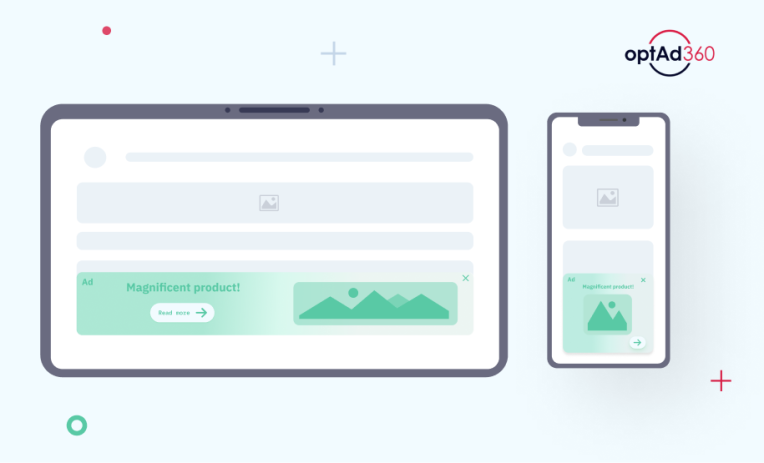
In a story revolving around digital advertisements, there are two perspectives to consider: there are publishers on one side and advertisers on the other. The first group is deeply concerned about generating revenue from displaying ads, whereas the second one prioritizes the visibility and reach of their ad creations. So, how can we fulfill the needs of both parties? Turns out, the answer is rather simple – responsive display ads! Let us explain what these are and what are the benefits of having them in your ad inventory.
What is responsiveness
Let’s start with the basics, by explaining the term of responsiveness. Usually, in computer science, it refers to how quickly a system or program can respond to tasks or commands. However, it’s important to note that responsiveness is occasionally put into the context of responsive design, which is a completely different topic. Simply speaking, it applies to all websites and apps that are designed to adjust their elements to different screen sizes of devices on which they’re displayed by users. As digital technology keeps on evolving, people access the online world through many different devices, from smartphones and tablets to laptops. What makes the matter more complicated is how different the devices’ sizes are – the largest screen size available on the mobile phone market is around 6×6 inches (approx. 15×15 cm), whereas the smallest one has only 4×2 inches (around 10×5 cm). Websites and apps must perform equally well on all the available sizes, which might be a challenge for some designers.
Now that we know what responsive design is, let’s find out more about responsive advertisements!
Responsive display ads
In a nutshell, responsive advertisements are digital ads that adjust their size to the ad slots in which they will be placed. One type of responsive advertisement is the native ad, which is made of scalable and adjustable components, thanks to which it adapts well to the content and blends seamlessly with the surroundings. Among others, it automatically matches the fonts and colors of a website or mobile app.
In the image below, you can see how the same responsive display ad acts on different devices (with completely different screen sizes):

Google RDA
When designing responsive ads on Google Ads, advertisers can provide a broad range of elements, such as images and headings, which are later flexibly combined and resized to accommodate different sizes of ad slots. This enables a wide array of creative options within a single advertising campaign, ultimately leading to a greater chance of effectively filling the ad slots in your ad inventory.
Interestingly, not only are parts of responsive ads resizable, but some ad slots in your ad inventory might also expand slightly. This might happen when the user’s device has more width and is capable of showing wider ads. This is not yet a popular solution, but Google is working to make it more accessible.
Benefits of responsive display ads
- One of the primary advantages of RDAs is their versatility. They seem different depending on what ad slot they’re displayed in. That’s why the audience is less likely to experience ad fatigue, which ultimately can be harmful to your ad revenue. Luckily, the responsive ads’ variety helps to avoid situations when users omit ads due to the phenomenon known as banner blindness;
- Additionally, thanks to the numerous available sizes of responsive ads, there are more chances to fill the ad slots within your ad inventory, which means a higher probability of achieving a good ad fill rate. It simply doesn’t matter what the size of the ad slot is – the responsive ad always fits perfectly;
- Responsive display ads provide profitable monetization results while maintaining a satisfactory User Experience. Why? Because – thanks to algorithms – each element has its own place and fits well into the website or mobile app’s ad slots. There are no chances for displaying some weird pixelated or cropped photos to your audience;
- Having responsive ads as part of your monetization strategy enables you to tap into the extensive reach of the Google Display Network – one of the largest ad networks worldwide. As the fundamental ad type for GDN, responsive ads offer the widest audience reach among all display advertisements. It means that when you have responsive ads within your monetization arsenal, you are able to attract a diverse range of advertisers to maximize your ad revenue-generating opportunities.
Conclusions
Responsive display ads offer digital publishers numerous benefits, including improved User Experience and better monetization opportunities. In fact, they seem to be a necessity nowadays when we use hundreds of various device sizes. However, as a publisher, it can be difficult to keep up with all the latest technological innovations. This is precisely why with so many possibilities on the market, it’s important to work with a reliable partner who can take care of your ad inventory, no matter whether you write a blog, own a website, or design mobile apps. Our technology, powered by programmatic, optAd360 AI Engine, can help ensure that your ad slots are well-prepared for any kind of improvement, optimization, and ad, including responsive ones. Don’t wait – fill in the registration form and give it a try!


